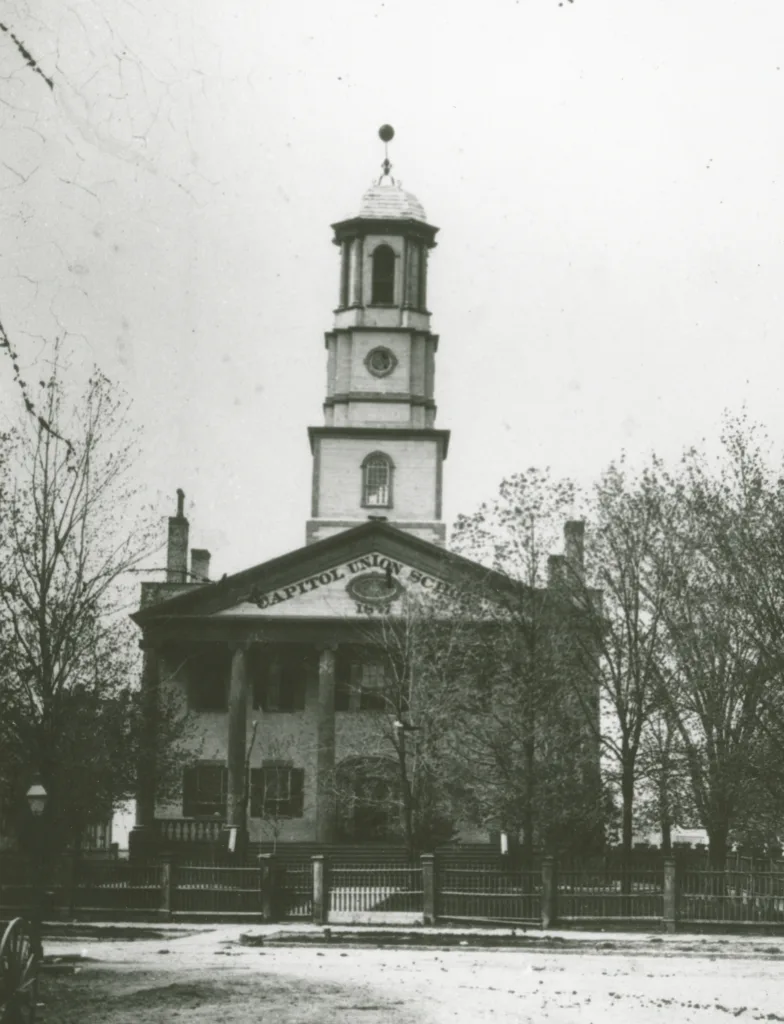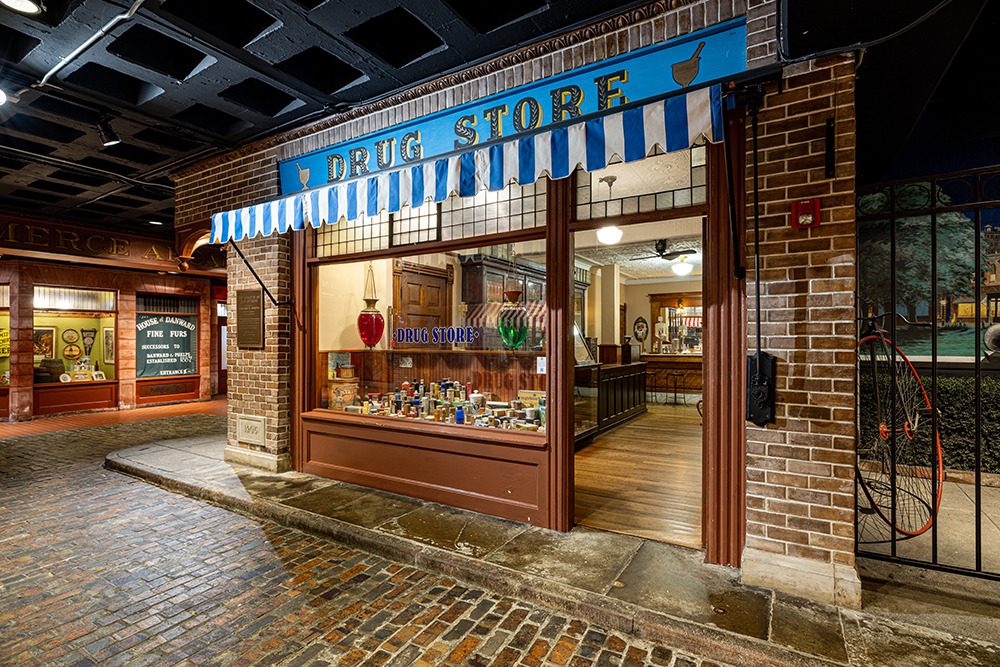
The Michigan State Capitol circa 1890. (Source: Archives of Michigan)
How the Capitol came to Lansing.
People sometimes wonder why Michigan’s capital is Lansing and not, say, Detroit, the state’s largest and most populous city.
But Lansing wasn’t always the capital of Michigan. That’s what we’re here to talk about.
In the beginning: Detroit

Illustration of Detroit in 1818. (Source: University of Michigan Clark Library)
Our story begins before Michigan was even a territory of the United States. For years, French traders had established themselves in the Great Lakes region—even founding the oldest city in Michigan, Sault Ste. Marie, in 1668.
Down the east side of the Mitten, French officer Antoine de la Mothe Cadillac noticed that the north bank of the Detroit River was especially well-placed for trade and farming. So in 1701, he established Fort Detroit there (officially named Fort Pontchartrain du Détroit).
Why “Detroit?” The word in French means strait, and it was used to describe the river connecting Lake Erie with Lake Huron.
With Montreal (roughly 575 miles from Detroit) and New Orleans (about 1,000 miles from Detroit) both French settlements, France’s government was keen to develop their new fort. So for many years, they offered free land to colonists looking to settle in the area, and Detroit became the largest European settlement between the former colonies of New France and La Louisiane.
After the Seven Years War, the British took control of France’s North American colonies. At the time, Detroit was the third-largest city in the Province of Quebec. Control of the city eventually passed to the US in 1796 as part of the Jay Treaty—an agreement to avoid war between the US and Great Britain.
Fast forward to 1805, when Congress formally established the Territory of Michigan. Naturally, they chose the largest and most developed city as its capital, and that city was, of course, Detroit.

1884 Illustration depicting the first state election in Detroit in 1835. (Source: British Library)
In 1835—two years before Michigan would formally become a state—the territory’s government crafted its first constitution. And in that constitution was written:
“The seat of government for this state shall be at Detroit, or at such other place or places as may be prescribed by law until the year eighteen hundred and forty-seven when it shall be permanently located by the legislature.”

Michigan’s first Capitol building, after being converted to a school. (Source: Archives of Michigan)
So, as the state became established, folks in other growing parts of Michigan argued that the capital city should be more centrally located. Detroiters, of course, argued that the capital should remain there.
And there was another consideration in the matter. Remember the War of 1812? That conflict was still fresh in the minds of Michiganders who were cautious of Detroit’s proximity to the British, who were still right across the river, after all.
Several cities, including Ann Arbor, Jackson, and Marshall, threw their hats into the ring to be capital. But two Ingham County men, State Senator Joseph H. Kilbourne and James Seymour, a land speculator and local landowner, suggested that the sparsely populated Lansing Township would do nicely. Their argument could almost be considered the exact opposite of the argument for Detroit: The Lansing area had plenty of undeveloped land to build on, and offered cheap buildings to grow into.
With much debate swirling about the potential across the state, the Michigan House of Representatives quietly decided on Lansing—and their announcement was taken as a joke by some, who openly laughed upon hearing that this small township of fewer than 20 residents was now the capital city of Michigan.
The decision became official on March 16, 1847.
As new sights were set on Lansing, the state’s original Capitol building in Detroit, which had housed Michigan’s state government from 1835 to 1847, was converted into a school and library. The building burned down in 1893.
Also see:
Constructing the Capitol(s)

Michigan’s second Capitol, circa 1847. (Source: Archives of Michigan)
Throughout 1847, a wood building was quickly built to serve as the state’s temporary Capitol.
Quick aside: If you’re ever confused by the different spellings, just remember that a ‘capital’ is a city, and it has an a, like all of the city. A ‘Capitol’ is a building, and it has an o, like its one function (the building where the government meets). The word ‘Capitol’ is always capitalized, too.
Michigan’s temporary Capitol building had a simple two-story design that was topped by a tin cupola. Lawmakers conducted session there until 1871, when Governor Henry P. Baldwin pointed out the need for a new building. Lawmakers agreed, and a few months later, on March 31, 1871, they passed a bill kicking off construction on our third and current Capitol.
A commission was formed to oversee the construction, beginning with a contest to pick the design. Elijah E. Myers, a relatively unknown architect at the time, was selected from more than 20 entries. The commission chose Myers’ design because it met budgetary constraints while retaining an attractive and fireproof design.
The building’s cornerstone was laid on October 2, 1873. It was the most significant event that had happened in Lansing’s young history.
The Michigan Capitol’s notable features included a cast iron dome and a stone facade. The builders were also incredibly creative when it came to the internal design. Inexpensive materials like pine, plaster, pressed tin and cast iron were painted to mimic more expensive materials like marble and walnut.
Finally, on January 1, 1879, Michigan’s Capitol building was dedicated. It continues to house our state government to this day.

The Michigan State Capitol circa 1890. (Source: Archives of Michigan)
The Capitol today

Looking up inside the Capitol dome. (Source: Dave Parker / CC BY 3.0 Deed)
In the 144 years since its completion, the Capitol has undergone vast renovations and upgrades. While originally lit with gas, electricians worked for 30 years to wire it for electricity. Even today, some of the original gas chandeliers remain in operation.
In 1987, after a period of decline, a project was launched to restore the Capitol to its original beauty. The building was rededicated on November 19, 1992, following the restoration. It was also designated a National Historic Landmark in the same year.

The Capitol’s Michigan chandeliers, which run on gas. (Source: capitol.michigan.gov)
New additions to the building continue to be made. In 2022, construction was completed on Heritage Hall, a visitor and education space connected to the Capitol.
Over 115,000 people visit our Capitol every year. If you’re ever in Lansing, I highly suggest you treat yourself to either a guided or self-guided tour. It truly is a beautiful sight to behold, with many stories just waiting to be discovered within its walls.

That one time in Michigan: When America’s only floating post office set sail
Does the zip code 48222 ring a bell? Unless you have a loved one working on a Great Lakes freighter, probably not. But if you want to send a love...

A historian’s guide to living history in and around Detroit
You’ve studied Michigan history, but why not live it? Check out one historian’s guide to the best ways to bring history to life in Metro Detroit....

That one time in Michigan: When we had our deadliest tornado
June marked the 72nd anniversary of the deadliest tornado in Michigan’s history. Learn about the Flint-Beecher tornado, its impact, and its lasting...

75 years after the then-worst crash in US history, search ends for a plane in Lake Michigan
SOUTH HAVEN, Mich. (AP)—A group is ending a 20-year search for a plane that crashed into Lake Michigan in 1950, killing all 58 people on board,...

A guide to what the Juneteenth holiday is and how to celebrate it
It was 160 years ago that enslaved people in Galveston, Texas, learned they had been freed — after the Civil War's end and two years after President...





